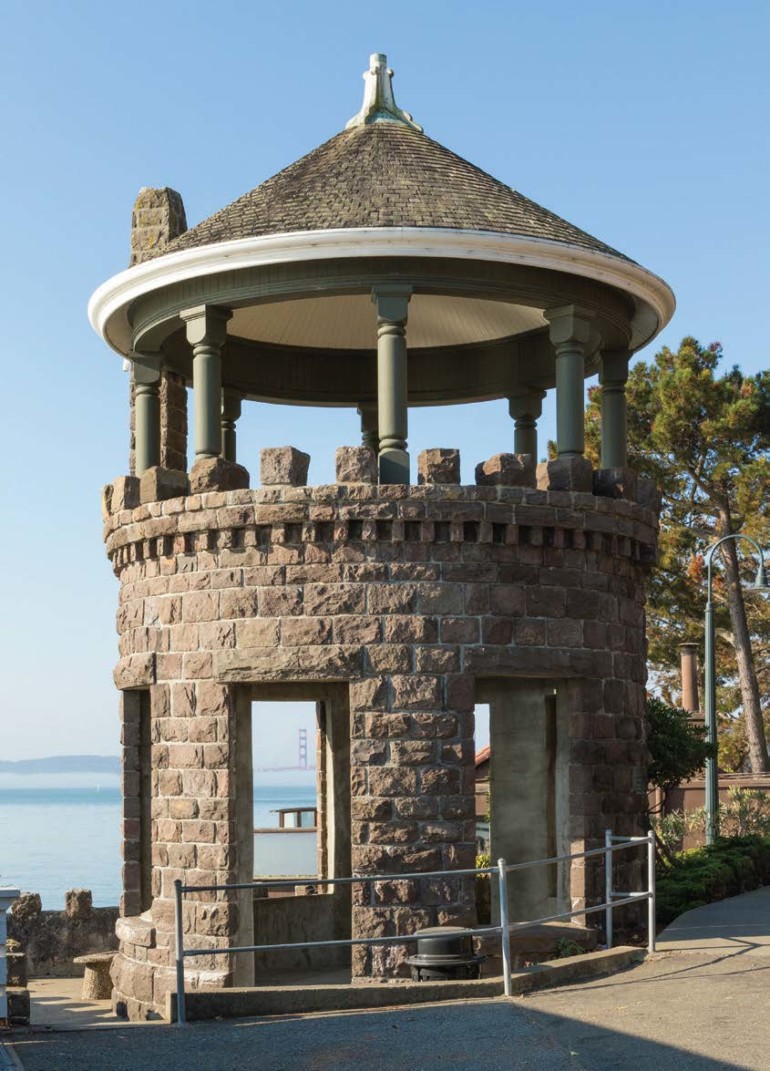Today, a small stone tower on Paradise Drive serves as a reminder of the grand plans Dr. Benjamin Lyford once had for the pristine slice of peninsula he owned with his wife, Hilarita Reed. One of John Reed’s two daughters — the original land grantee for the area now known as Rancho Corte Madera del Presidio — Hilarita had an inheritance she shared with Lyford after marrying the San Francisco embalmer in 1872.
While he worked with the dead, Lyford was keenly obsessed with health. He also had lofty ambitions for his wife’s land, envisioning a utopian village he would call “Lyford’s Hygeia” (Hygeia being the Greek goddess of health). There all residents would adhere to a number of rules — all meals must be eaten outside; no house could rest in the shadow of another — conceived by Lyford in the belief they would promote good health.
The tower, along with the Lyfords’ home — which was moved in 1957 and is now better known as Tiburon’s Richardson Bay Audubon Center and Sanctuary — is all that now remains of the doctor’s vision. Originally the tower was accompanied by an arch that stood until 1926, when Marin officials decided to repave some of Tiburon.
“There was no straight road into Tiburon,” David Gotz, Tiburon’s town historian, explains. “You had to go around Paradise Drive to get into Tiburon for a long time. They widened it in 1926, and in widening it, they took down the arch. We don’t know what happened to the stones. Possibly they were just thrown down as riprap along the shore there. From then on, it was just the tower.”
Unfortunately for Lyford, his efforts to sell parcels of the land as part of his utopian village were unsuccessful. He died in 1906, and when Hilarita passed in 1908, the property was passed down to other direct descendants of the Reeds, including the Boyles (of Mill Valley’s Boyle Park) and the Deffebachs, who Gotz notes “owned most of the center part of the Tiburon peninsula.”
The odd little tower — now emblazoned with a small plaque commemorating its historical significance — still watches over Angel Island today, thanks in part to the foresight of individuals who saw its value was far more than simple stone and mortar.
When Lyford’s descendants sold the property in the late 1950s, Tiburon was still part of unincorporated Marin County. The land’s new owner applied to build three duplexes on the lots, but the Marin County Planning Commission had other ideas. The parties negotiated, agreeing that two triplexes could be built on the adjacent lots if the owner placed a scenic easement on the parcel containing Lyford’s Tower for 25 years.
Tiburon incorporated in 1964, and a few years later, the Belvedere-Tiburon Landmarks Society took an active interest in preserving the tower.
“The Landmark Society spruced it up and did a lot of earthquake refitting,” Gotz says. “Finally, in 1976, the Landmark Society — as well as the town historian — did the work to get it designated as a National Historic Landmark.”
Today, curious visitors still find their way to the lone stone structure that offers breathtaking views and a captivating portal into the past. The arch may be gone, but the remnants of Lyford’s utopia — a vision of health and splendor — live on in the city that has risen in its place.
To learn more about Lyford’s Tower, visit landmarkssociety.com.
 Zack Ruskin lives in San Francisco, where he writes on music, film, comedy, cannabis, and culture. His work has appeared in Vanity Fair, Billboard, Interview, San Francisco Chronicle, Bandcamp, Maxim, Uproxx, Consequence of Sound, SF Weekly, Paste, and The Believer. He writes SF Weekly’s “Chem Tales” column on the cannabis industry. He donates monthly to Planned Parenthood, and on the local front, supports the St. James Infirmary and Women’s Audio Mission.
Zack Ruskin lives in San Francisco, where he writes on music, film, comedy, cannabis, and culture. His work has appeared in Vanity Fair, Billboard, Interview, San Francisco Chronicle, Bandcamp, Maxim, Uproxx, Consequence of Sound, SF Weekly, Paste, and The Believer. He writes SF Weekly’s “Chem Tales” column on the cannabis industry. He donates monthly to Planned Parenthood, and on the local front, supports the St. James Infirmary and Women’s Audio Mission.


